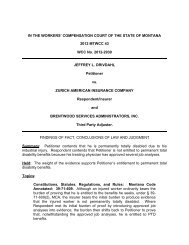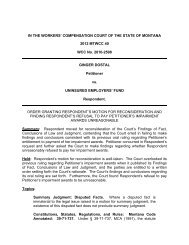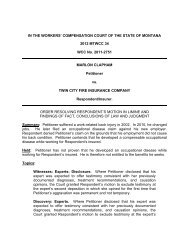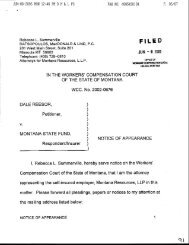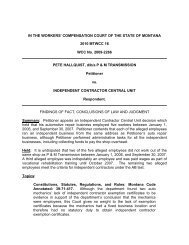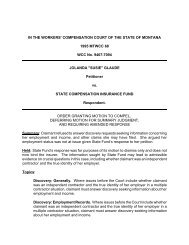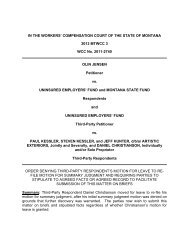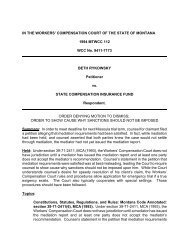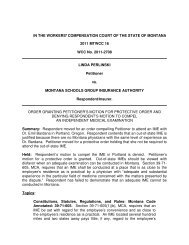Order Granting Respondent's Motion for Summary Judgment
Order Granting Respondent's Motion for Summary Judgment
Order Granting Respondent's Motion for Summary Judgment
- No tags were found...
You also want an ePaper? Increase the reach of your titles
YUMPU automatically turns print PDFs into web optimized ePapers that Google loves.
same set of facts, I can think of several possible explanations <strong>for</strong> National Laundry’sfailure to give Trevino her job back – some benign, some not. Although Trevino’sspeculation led her to conclude that National Laundry does not think she can per<strong>for</strong>mher time-of-injury job due to her industrial injury, Trevino has not proffered any evidencein support of this speculation and there<strong>for</strong>e I cannot conclude that it constitutes a factualdispute precluding summary judgment. 30 From the evidence be<strong>for</strong>e the Court, I do not see any possible way in whichTrevino can prove that she is precluded from per<strong>for</strong>ming her time-of-injury job and isthere<strong>for</strong>e entitled to PPD benefits. There<strong>for</strong>e, I conclude that State Fund is entitled tosummary judgment in its favor on this issue.II. Whether this Court should grant summary judgment to State Fund on theissue of Trevino’s entitlement to vocational rehabilitation benefits. 31 State Fund further argues that it is entitled to summary judgment on Trevino’sclaim <strong>for</strong> vocational rehabilitation benefits. State Fund notes that, pursuant to § 39-71-1006(1), MCA, an injured worker is eligible <strong>for</strong> rehabilitation benefits if the worker meetsthe definition of disabled worker as provided in § 39-71-1011, MCA, or if the worker has,as a result of the work-related injury, a whole person impairment rating of 15% orgreater. State Fund contends that Trevino does not meet the basic eligibilityrequirements <strong>for</strong> rehabilitation benefits because she is neither a “disabled worker” asthat term is defined in the Workers’ Compensation Act nor does she have a wholeperson impairment rating of 15% or greater. 32 It is undisputed that Trevino received a whole person impairment rating of 1%.There<strong>for</strong>e, the only way in which she would be eligible <strong>for</strong> rehabilitation benefits under§ 39-71-1006, MCA, is if she meets the definition of disabled worker as provided in §39-71-1011(2), MCA, which states:“Disabled worker” means a worker who has a permanent impairment,established by objective medical findings, resulting from a work-relatedinjury that precludes the worker from returning to the job the worker heldat the time of the injury or to a job with similar physical requirements andwho has an actual wage loss as a result of the injury. 33 Trevino argues that, if this Court determines that she cannot per<strong>for</strong>m her time-ofinjuryjob as an ironer at National Laundry, then she would qualify as a “disabledworker” under the applicable statutes. 35 As set <strong>for</strong>th above, I have not made such adetermination. There<strong>for</strong>e, I further conclude that Trevino is not a “disabled worker” as35 Response Brief at 6.<strong>Order</strong> <strong>Granting</strong> Respondent’s <strong>Motion</strong> <strong>for</strong> <strong>Summary</strong> <strong>Judgment</strong> – Page 7



![Bustell v. AIG Claims Service, Inc. [05/03/05] 2005 MTWCC 23](https://img.yumpu.com/49777654/1/190x245/bustell-v-aig-claims-service-inc-05-03-05-2005-mtwcc-23.jpg?quality=85)
![Vallance v. MCCF [07/05/06] 2006 MTWCC 26 - Workers ...](https://img.yumpu.com/48724322/1/190x245/vallance-v-mccf-07-05-06-2006-mtwcc-26-workers-.jpg?quality=85)
